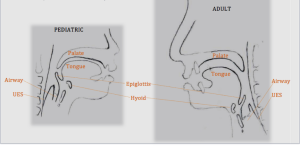Pediatric Anatomy
Infant anatomy differs from adult anatomy largely in size, but the relative space also differs (Box 1.30). When compared to the adult, the newborn has a smaller oral space. This is due primarily to three anatomical factors: (1) presence of sucking pads, (2) an oversized tongue, and (3) a small and retracted mandible. Sucking pads, present at birth, are compacted masses of fat within the masseter muscle and buccal tissue. They typically begin to resorb (shrink) sometime after six months of age. The infant’s tongue is oversized for the oral space. The oversized tongue combined with the sucking pads result in a smaller oral space, thus improving accuracy and success of nipple compression for feeding. The jaw is retracted and smaller with respect to the adult. This allows the mouth of an infant to be closely opposed to the mother’s breast for feeding.
Box 1.30: Pediatric compared to adult anatomy

In addition to the oral anatomical differences, the hyoid and larynx are positioned high in the neck. This results in close approximation of, and in some infants the juxtaposition of, the soft palate and epiglottis presenting a barrier between the oral and pharyngeal cavities (Stephens, Bancroft, Glaros, & Lowe, 2010). The close opposition of the velum and epiglottis serves to separate the oral cavity and the airway rendering infants obligate nose breathers (Trablon & School, 2012). Further, this approximation generates access to the vallecular space that can be used to hold liquid that has been extracted, but not yet swallowed. At birth, the hyoid is at a level relative to C2. Over the first year of life, the hyoid and larynx will descend at a fairly constant rate. By 2 years of age the hyo-laryngeal complex will attain a more adult position with respect to the cervical spine at the level of approximately C4 (Carlsoo & Leijon, 1960; Roche & Barkla, 1965; Westhorpe, 1987).
Moving into adolescence, buccal cavity sucking pads will be diminished in size and the mandible will become protracted. Thus, the oral space becomes respectively and physically larger. The neck and pharynx will continue to elongate throughout adolescence.

